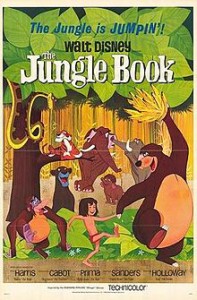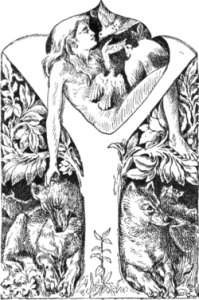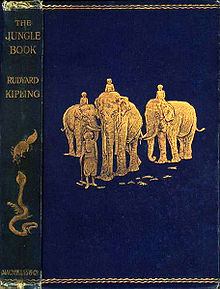The Jungle Book ***** (1967, voices of Phil Harris, Sebastian Cabot, George Sanders, Louis Prima, Sterling Holloway, J Pat O’Malley, Verna Felton, Bruce Reitherman) – Classic Movie Review 2405
Director Wolfgang Reitherman’s tremendous 1967 Walt Disney Productions animated film, inspired by Rudyard Kipling’s children’s classic book of Mowgli stories, is nothing short of a magical experience. It is the 19th animated feature in the Walt Disney Animated Classics series.
The director’s son Bruce voices the Indian feral boy Mowgli, who is abandoned in the jungle, raised by wolves, captured by apes, hunted by a boy-eating tiger and adopted by a bumbling bear named Baloo. Bagheera the Panther (voice of Sebastian Cabot) takes on the responsibility of taking him back to his village. But Bagheera and Baloo the Bear (Phil Harris) have a difficult time trying to convince a boy to leave the jungle for human civilization.
Along the way we meet pompous Colonel Hathi the Elephant (J Pat O’Malley), swinging King Louie of the Apes (Louis Prima), sneaky Kaa the Snake (Sterling Holloway) and the tremendously evil tiger Shere Khan (George Sanders).
This was the last full-length feature supervised by Walt Disney as producer himself and he ensures that his team’s attention to detail, especially to the lush jungle backgrounds and the wonderful set of characters, is a vital ingredient in making this the best of the studio’s work of the period.
After the disappointing reaction to The Sword in the Stone, Walt Disney decided to become more involved in the story and ‘certainly influenced everything about it. He obviously got hooked on the jungle and the characters that lived there,’ said his nephew Roy E Disney. Sadly, though, Disney died during the film’s production.
Director Reitherman ensures that the pace of the story-telling never lets up. Mowgli’s ready acceptance of his place in the village and his desertion of his jungle pals add a touch of poignancy and awareness of adulthood to the high jinks that precede it.
It helps enormously that the Sherman Brothers’ songs are so top notch, with toe-tapping hits in ‘I Wanna Be Like You’, ‘That’s What Friends are For’ and ‘Trust in Me’). However, perhaps the show-stopper is when Baloo the Bear (Phil Harris) sings Terry Gilkyson’s Oscar-nominated evergreen favourite ‘The Bare Necessities’. Composer Gilkyson and writer Bill Peet were replaced when they tried to replicate the sinister tone of Kipling’s book, which Disney did not want in his family film.
It’s impossible not to be swept away by the sheer fun and joy of it all. The public of the day loved it and it became one of Disney’s most financially successful animations. It grossed over $73 million in the United States on its first release, and as much again from two re-releases. And it has remained a firm and enduring favourite on its TV screenings over the years, as well as on home viewing.
Disney released a live-action remake in 1994 and an animated sequel, The Jungle Book 2, in 2003. Many of the film’s characters appeared in House of Mouse, The Lion King 1½, Who Framed Roger Rabbit and Aladdin and the King of Thieves.
The film’s source work, The Jungle Book (1894), is a collection of stories by English author Rudyard Kipling. The stories were first published in magazines in 1893–94. The original publications contain illustrations, some by Rudyard’s father, John Lockwood Kipling. Mowgli is a feral child from the Pench area in Central India, who originally appeared in Kipling’s short story In the Rukh (collected in Many Inventions, 1893).
© Derek Winnert 2015 Classic Movie Review 2405
Check out more reviews on http://derekwinnert.com







